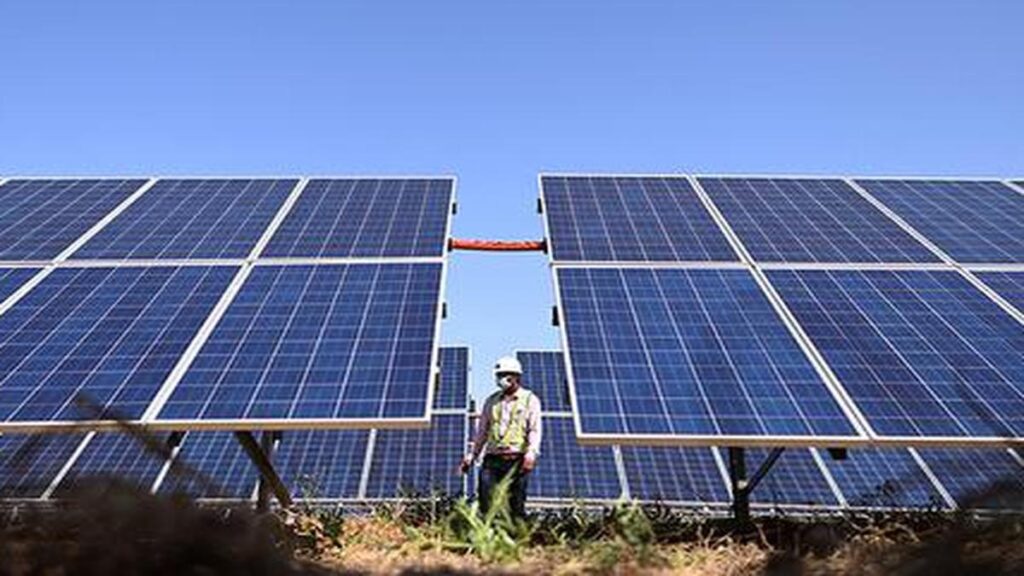
From an airport without an ATC gateway to a park for renewable energy five times Paris’s size
Situated in the middle of miles of desolate land bordering Pakistan, a narrow airstrip with no air traffic controller to direct arriving planes and only a makeshift office in a container for restrooms is an unlikely entryway to the largest renewable energy park in the world.
The airfield was much smaller in December 2022 when Gautam Adani, the head of the Adani company and the second richest man in the world at the time, arrived at the desolate region—which lacked a pincode and took its name from a village 80 kilometers away—using a small plane.
Because of its extremely saline soil, the land rarely supported any flora, let alone any human habitation. However, the region was unused for a renewable energy park despite having the second-best solar radiation in the nation, after Ladakh, and wind speeds five times higher than lowlands.
His group’s 538-square-kilometer (approximately five times the size of Paris) Khavda renewable energy park is located an 18-kilometer drive from the airstrip through dry, parched land.
According to his executives, Adani made a joke when he initially arrived at Khavda, asking whether anyone could see a mosquito nearby.
Since then, though, his group has installed desalination plants to create portable saline water that is pumped out of 700 meters below ground, as well as utilities like mobile phone repair shops, in addition to installing solar panels that will convert sunlight into electricity and wind mills to harness wind blowing at a speed of 8 meters per second.
According to its Managing Director, Vneet Jaain, Adani Green Energy Ltd., the biggest renewable energy firm in India, will invest roughly ₹1.5 lakh crore to produce 30 megawatts of clean electricity at Khavda in Gujarat’s Kutch region.
“We have just now commissioned 2,000 MW (2 GW) of capacity at Khavda and plan to add 4 GW in the current fiscal (financial year ending March 2025) and 5 GW every year thereafter,” he stated.
A few times a week, group executives from Ahmedabad or Mundra are transported by plane to the airstrip.
The final air traffic controller (ATC) station for aircraft traveling to Khavda is located in Bhuj, approximately 160 kilometers away. However, its range ends at “Tent City,” and for the final 80 kilometers or so, including landing, pilots are essentially on their own.
“To land, we make use of the navigation systems on aircraft and visual aids. The pilot of the aircraft operated by the Adani Group stated, “We communicate with Bhuj regarding the arrangements by phone before to takeoff.
The energy park’s outer flange is located just one kilometer from Pakistan’s international border. The BSF staffs the one-kilometer barrier.
According to executives, the airstrip was constructed in a just 35 days, despite the need to modify tractors to function on non-absorbent terrain.
Also read: Earth is swept by a total solar eclipse in 2024, with breathtaking sights

The region faces a unique mix of difficulties, including intense dust storms from March to June, a lack of infrastructure for transportation and communication, an 80-kilometer distance to the closest inhabited area, water not seeping through the ground during the rainy season, saline ground water, and the area being a restricted zone.
Executives stated that while housing for 8,000 workers is being constructed, some workers from Khavda village will remain.
The Adani Group has the most ambitious renewable energy goals of any corporate in the nation. As part of a larger strategy to achieve net-zero emissions by 2070, the company aims to generate 500 GW of electricity from non-fossil sources by 2030.
According to them, Khavda can power entire countries like Belgium, Chile, and Switzerland with its peak output of 81 billion units.
According to Jaain, the 30 GW at Khavda would be made up of 4 GW of wind and 26 GW of solar power.
The current operational portfolio of AGEL consists of 2,140 MW of wind-solar hybrid capacity, 1,401 MW of wind, and 7,393 MW of solar power.
The Khavda region has one of India’s strongest wind resources, with speeds of up to 8 meters per second, and high sun irradiation of 2,060 kWh/m2. However, frequent sandstorms make it necessary to clean solar panels multiple times a day.
According to officials, waterless robotic module cleaning systems will cover the entire project. The government owns the land in Khavda and has leased it to the Adani company for a 40-year period.
Executives stated that before beginning development of this site, Adani Green carried out a number of studies over the previous five years, including geotechnical investigations, seismic studies, a centrifuge study by Cambridge, resource assessments and land studies, Environment and Social Impact Assessments (ESIA), Environmental and Social Due Diligence (ESDD), and a thorough feasibility study.
In 2022, construction got underway. A total of 180 km of optical fiber cables were laid for connectivity as part of the extensive infrastructure development project, which also included the building of concrete batching plants, 50 km of drainage, 100 km of roads, and three reverse osmosis (RO) plants with a combined capacity of 70 cubic meters per hour to meet the project staff’s drinking water needs.




































































































































































































































































































































































































































































































































































































































































































































































































